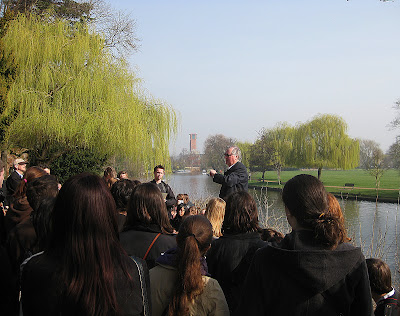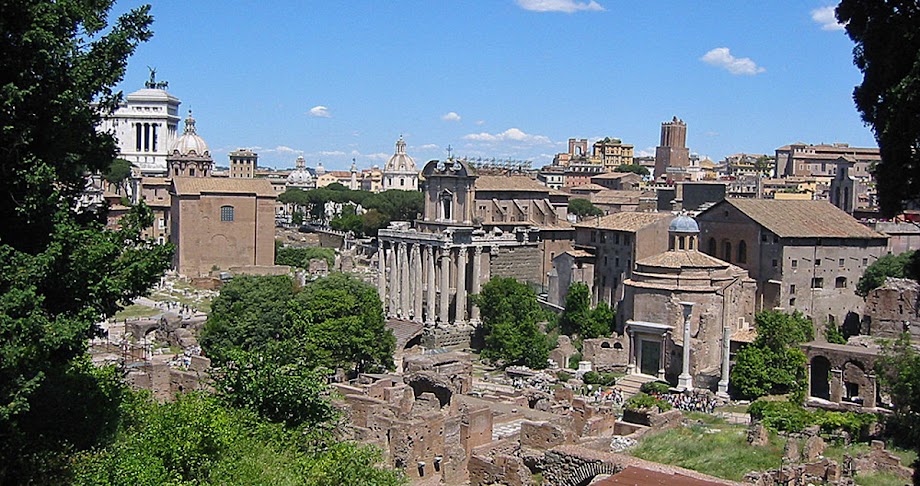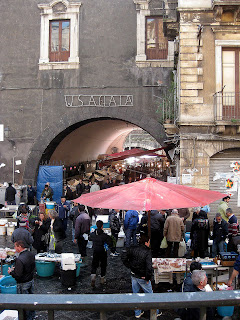BUT! Allow me to say a few words about the London Center trip we took this past weekend, and put up several photos -- I have already posted some photos on of the excursion on facebook. so have a look at those as well, if you'd like.
The trip was the fourth and last trip the group took this semester, but only the second I've been on. I had decided against the Bath trip, as I've been to that
 |
| The City of Warwick from a tower in the castle |
elegant city several times now, was not ready to climb Glastonbury Tor again, nor all that keen on walking around Stonehenge for the third time. Don't get me wrong, the henge is a thrill at first, but in this case I doubt three times would have been the charm. The Edinburgh trip I was looking forward to, as it would have been only the second time I'd have been to that city other than during the festival, but alas I was too ill to take advantage of it. A blessing as it turned out, as I'd have had to climb Arthur's Seat, and apparently a windy snowstorm hit just as the students reached the peak! The third trip was to Paris, which I loved, but for some reason I didn't write about, probably because we pretty much copied what we did in the autumn.
This past weekend's trip was also a fair copy of the fall excursion to Stratford, but even though it's a bit of a tourist trap, I really have fallen for that city, and there was one important difference in that we were to see a new show at the RST, Twelfth Night. So, all in all I had more incentive for this outing than for the trip to Bath.
 |
| Warwick castle on a misty morn from one of its towers |
Almost as soon as we arrived at Warwick Castle, however, I found myself wishing that, like several of the other faculty (Tim Kidd, Patricia Doyle, Ashoke and Mun Mun Chanda, and Lee White) I had gone directly to Straftord by train and given the Castle a miss. Of all the castles I've been to in the U.K., Warwick is the least dignified in that it is the most Disney-fied, or to be more accurate, Tussaud-ified! The good Mme's organization bought it in the 1970s, I believe, and walking through the rooms you nearly have to squeeze by all the wax effigies. The only surprise is when one of the effigies rises! Not a real effigy of course (is there such a thing as a real effigy?) but a historical enactor whose job it is to talk in character a bit about what about the room is of interest.
 |
| The students and the archer, from the castle ramparts |
It's all rather tedious. Give me a ruined caslte, such as Chepstow or Conwy in Wales, any day instead. I DID scale the ramparts and towers while the students stopped by the same archer we'd seen back in September, who was equipped with the same bow and quiver of arrows, and of the same lame jokes. The trebuchet was blared about for 20 minutes and was fired in less than 20 seconds and then was finished, and while the birds of prey might have been better -- the event was placed inside the castle itself this time around, which seemed more appropriate than in the field outside it where it was offered in the fall -- I had had enough and took myself to the restaurant for a large, fattening and very tasty sandwich instead.
After my lunch I bumped into Claire Mokrauer-Madden, my former student and present member of ICLC staff, and Jim Swafford, the other visiting faculty member, and we headed almost immediately out of the castle and into the city.
 |
| Jim, Claire and a student waiting for tea |
I must admit that I found the town of less interest than I thought it might be on my visit last autumn, when I thought it might have deserved an overnight visit, but we had a good stroll, and a decent pot of tea with scones and clotted cream outside in a aquare, as the weather was so lovely. We also took in the Collegiate Church of St Mary, which IS worth revisiting if only for the beautiful chapel in which some of the Earls of Warwick (including Richard Beauchamp, thirteenth of those earls, and jailer of Joan of Arc) and an Earl of Leicester (Robert Dudley, favorite of Queen Elizabeth I) are buried.
 |
| The Beacham Chantry has been called the finest Medieval chapel in England |
A historical and artistic gem in an otherwise not all that extraordinary church. All in all, I was delighted to get back on board the coach and to set off for Stratford.
Stratford-Upon-Avon does not disappoint -- me, at least. There are many that complain it is a tourist trap, and indeed many tourists seemed trapped, albeit willingly there on the beautiful Friday afternoon and Saturday morning that we spent there. But to me it is a lovely Cotswolds town that has retained much of its history and its well and accurately preserved past. And it's not Disney-fied/Tussaud-ified like Warwick Castle, with the exception of of rather tacky-looking Tudor experience that I've never forced myself to enter. Of COURSE it's Shakespeare's birthplace! Damned good reason to celebrate!
 |
| The River Avon and the elegant Holy Trinity Church, Stratford |
I must admit that I missed Moss Cottage, the B&B well out of the center (but worth the walk) that I'd stayed in twice during the fall semester. But the Virginia Lodge gave me a great bed and if not as good a breakfast as had Moss Cottage, a more than acceptable one.
 |
| My white bed! |
My bed was a fourposter, covered in white lace -- a bit too much like a tiny bridal suite to suit my taste, but the bed and bedding were so warm and comfy that I didn't at all mind the bit of mis-fit. I didn't stay in the room long after arrival, however, as we had dinner reservations at 5 pm, followed immediately by the play, and I wanted a stroll along the river before dining.
I met Jim Swafford and showed him where dinner was to be et, at the Opposition, more usually shortened to the Oppo, on Sheep Street, then took my stroll, then dined VERY well on sea bass with a duck starter, and more wine than was probably good for me.
Twelfth Night, alas, was a trifle disappointing -- some of my colleagues would have called their disappointment more than a trifle -- Orsino usually utters the famous first lines of the play: "If music be the food of love, play on, give me excess of it..." but in this version that scene is preceded by Viola rising, gasping, out of a pool. Not a bad entrance, not a bad use of the pool, not a bad start to the play, but except for Sebastian's rising in the same fashion later in the play every subsequent use of the water seemed contrived and forced. Orsino was dull and unappealing. What iola might have seen in him is beyond me. Viola herself was on and off for me. I liked Olivia better. Toby and Andrew were fine, but nothing inventive or new with those two. Malvolio handled the letter scene well, but was so sabotaged by his costume when he returned yellow-stockinged and cross-gartered, and...well, there are some things I think it's best to leave out...that I felt bad for him long before his imprisonment in the play -- he was imprisoned so embarrassingly in his own costume that the darkest dungeon would have seemed light and airy in compare. The set was not uninterestng to look at, but what did it have to do with the play?
Ah well, it's a much more difficult play to get "right" than people imagine, and most productions I've seen have been disappointing. Of course none of those had me as Orsino, which role I played back in Washington DC in the middle ages; well, the mid-1970s. I was very good.
After the play I was so tired and as noted above somewhat disappointed, so I skipped the Dirty Duck, which has never enchanted me, not since my first visit there in 1986 when I made a completely lame and unsuccessful pass at Imogen Stubbs. Instead I helped an ailing Bonnie Lawrence and a very tired Jim Swafford back to the B&B, and slept soundly in my wonderful bed.
The next morning we heard Tim Kidd speak adroitly and eloquently on Shakespeare in Stratford. The students then visited Holy Trinity Church to pay their respects, and then the good Doctor Kidd took us on a walk to a few of the Shakespeare properties. After that we wandered, and Claire MM and I again slipped off for food -- paninis this time at a place I think called "The Food of Love" across from the Shakespeare birthplace. I then wandered along the river, on this beautiful Saturday one of the few places not completely cram-packed with tourists, before bidding a silent adieu to Stratford (when will I see it again? WILL I ever see it again?) heading to the bus for a short stop in Oxford.
I think I may have written last fall that by this time in the trip I am tired and ready to go home. We had less than two hours in Oxford, which is too little time to take in much of it, but all the students wanted to see waa anthing to do with Harry Potter. Oxford was completely crowded with tourists (us included of course) so Claire MM, my partner in crimes of food and drink this on this hourney, and I went to the indoor market, found a nice place that served tea and cakes, had a chat, then toured through the Greek and Roman section of the excellent Ashmolean Museum, and once more boarded the bus, this time bound back for London! And not a moment too soon for this unusually reluctant traveler. Interestingly, my choice of tv for the evening was Inspector Morse, an altogether easier way to see Oxford than by traipsing through it on a touristy Saturday.
 |
| Tim Kidd explains it all for us, the new tower of the RST rising in the background |
 |
| Stratford -- on the far right the Garrick Inn and the Harvard house |











































